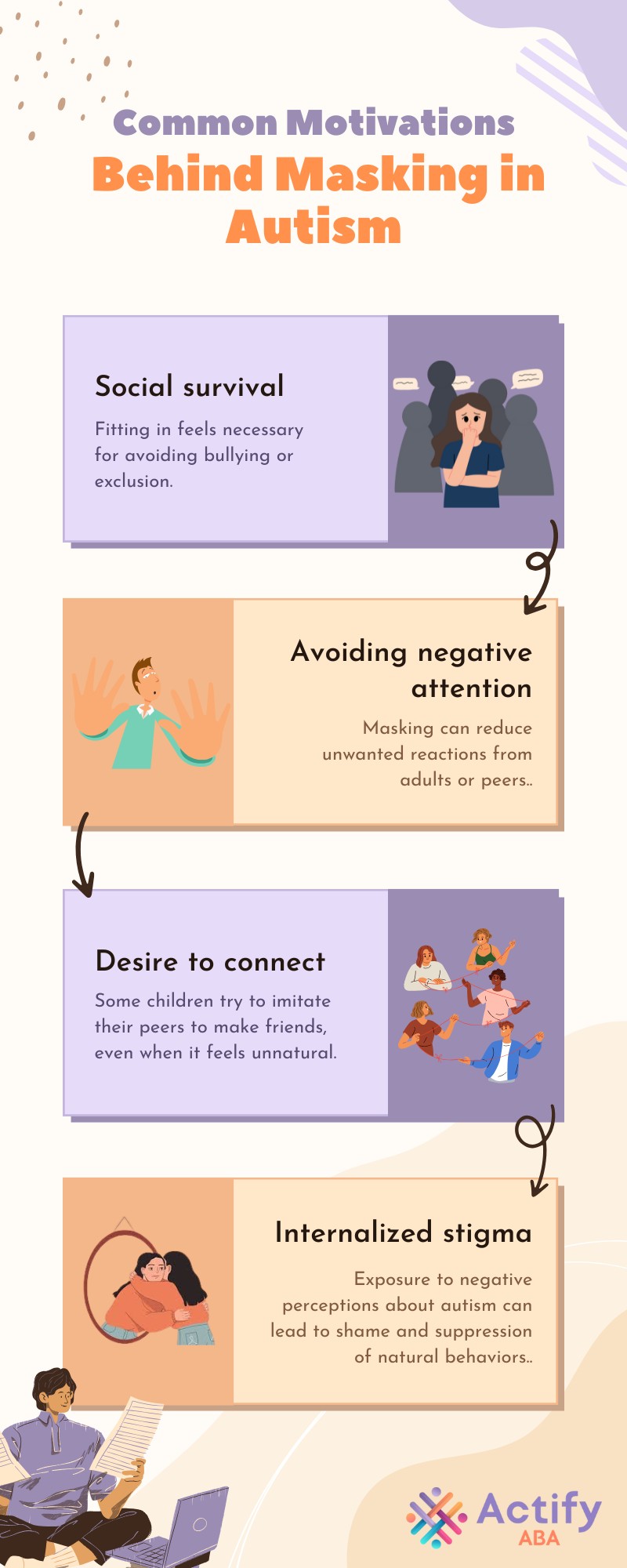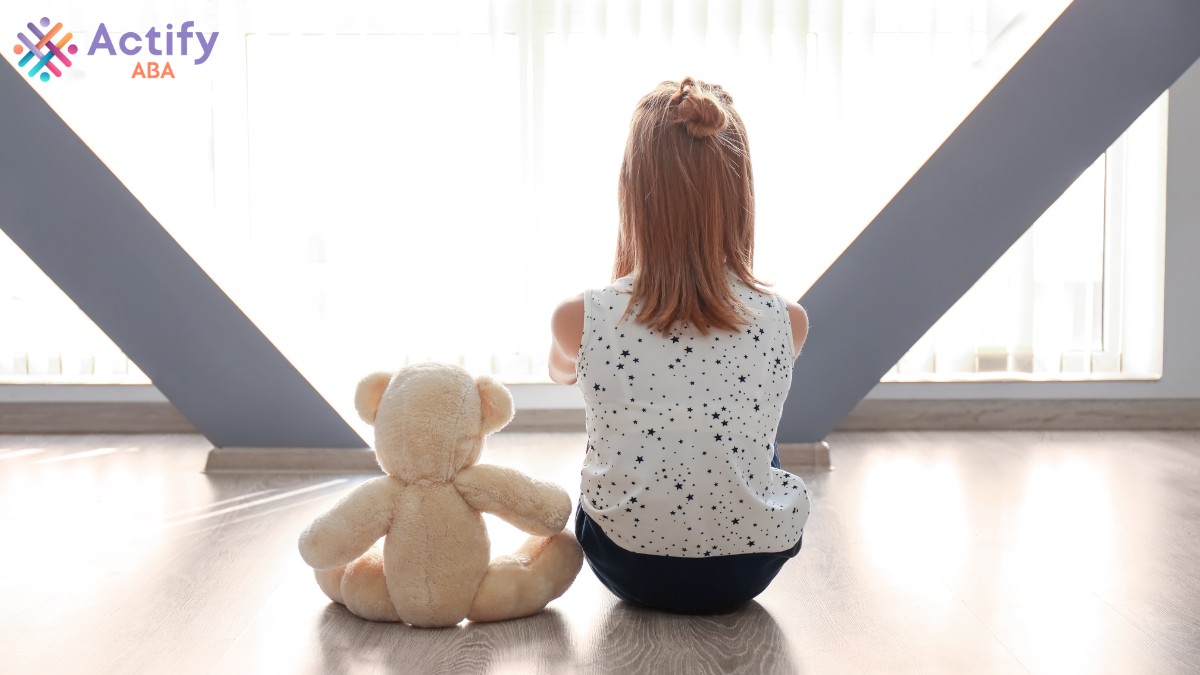
Key Points:
- The effects of masking autism often lead to exhaustion, anxiety, and identity confusion.
- Masking behaviors can delay diagnosis and contribute to poor mental health outcomes.
- Identifying and addressing masking early helps children build authentic self-expression and emotional well-being.
According to one study, approximately 70% of autistic individuals engage in a behavior called masking or suppressing their natural responses and traits to appear more “neurotypical.” This may involve forcing eye contact, mimicking others’ behavior, or rehearsing social scripts.
The effects of masking autism include chronic stress, burnout, depression, and difficulty with self-identity. Autistic individuals often suppress or hide traits to fit in socially, but this comes at a cost to their mental and emotional health. The long-term impact can be especially severe when masking begins early in life and continues unchecked.
While masking can help individuals navigate certain environments, it often comes at a significant emotional and psychological cost. In this article, we’ll discuss how masking manifests, why it occurs, and its long-term impact on mental health, including anxiety, depression, and burnout.
Why Do Autistic Individuals Mask?
Masking is often a learned response, shaped by external expectations and internalized pressure to blend in with peers. It doesn’t mean the autistic child is intentionally being deceptive—instead, they’re trying to protect themselves from judgment or rejection.
Over time, however, constantly hiding one’s true self can be exhausting. Many autistic individuals, even at a young age, begin to feel disconnected from who they really are, which can lead to stress, anxiety, and a sense of isolation, even when surrounded by others.
What are Some Common Motivations Behind Masking?
Autistic children may begin masking in early childhood or during their school years due to a range of social and environmental pressures. This behavior often develops as a way to navigate situations that feel unpredictable or demanding. Below are some common reasons behind masking:

Understanding these motivations is key to recognizing when masking may be harming a child’s well-being, even if they seem to be “coping” on the surface.
What Does Autism Masking Look Like?
Masking isn’t always easy to identify, especially in girls and children with higher support needs who may be skilled at mimicking neurotypical behaviors. Parents may not realize their child is masking until signs of emotional distress appear.
Common masking behaviors in children can include forcing eye contact, mimicking peers’ tone or slang, suppressing stimming, rehearsing speech, copying social cues without full understanding, and holding back questions or needs to avoid drawing attention. These behaviors are often used to blend in, even when they feel unnatural or exhausting.
Over time, these behaviors can create a disconnect between a child’s inner world and outer actions, leading to significant emotional strain.
How Does Autism Masking Affect Mental Health?
Masking might lead to short-term social acceptance, but it often results in long-term emotional costs. Many autistic individuals describe the experience as constantly “performing,” which is not only exhausting but damaging to their sense of identity.
The mental health effects of prolonged autism masking include:
1. Chronic Stress and Burnout
Continually hiding autistic traits requires significant energy. This mental load can result in what’s often called “autistic burnout,” characterized by fatigue, withdrawal, and decreased functioning.
2. Anxiety and Depression
The constant effort to conform, paired with fear of being “found out,” increases vulnerability to anxiety. The disconnect from one’s true self can also contribute to depressive symptoms.
3. Identity Confusion
Masking can lead children to feel they must hide who they really are to be loved or accepted, creating long-term issues with self-esteem and identity development.
4. Delayed Diagnosis and Support
Children who mask well often go undiagnosed for years. Without a diagnosis, they miss access to helpful resources and therapies tailored to their needs.
5. Difficulty in Relationships
Since masked behaviors aren’t authentic, they can create surface-level connections, which may lead to feelings of isolation or loneliness even in social settings.
Mental health struggles linked to masking often go unrecognized until they reach a breaking point—something that early intervention and support can help prevent.

Who Is Most Likely to Mask?
Not every autistic child masks to the same degree. Some children are more prone to camouflaging due to their environment, personality, or gender. Recognizing these patterns can help parents and caregivers understand what’s going on beneath the surface. Below are the most common demographics to mask:
1. Autistic Girls and Women
Studies consistently show that girls are more likely to mask than boys, which contributes to underdiagnosis. They may adopt masking strategies earlier and more thoroughly, making their autistic traits harder to recognize by teachers and professionals.
2. Children in Mainstream Schools
Children in mainstream educational settings are more likely to feel pressure to conform socially. The structured environment and peer expectations often drive these children to hide their natural behaviors in order to fit in.
3. Children with High Language Skills
Children with strong verbal abilities may have more capacity to mimic peers effectively. Their communication strengths can sometimes disguise underlying social or sensory challenges.
4. Teens
This age group often experiences heightened social pressures, increasing masking behavior. Adolescents may become especially aware of how they’re perceived and may mask to avoid bullying or social exclusion.
Identifying masking in these populations is crucial for timely and appropriate mental health support.
How Can Parents Recognize the Signs of Masking?
It’s not always obvious when a child is masking, especially if they seem to be doing “fine” at school but are melting down at home. Paying close attention to behavior patterns in different environments can reveal a lot.
Warning signs that a child may be masking include:
- Exhibits frequent meltdowns after social situations
- Constant fatigue, even after minimal activity
- High anxiety in new or group settings
- Strong need for control or routines at home
- Difficulty expressing feelings or asking for help
These behaviors might not seem connected at first, but they often point to the hidden effort of masking during the day.
What Are the Long-Term Consequences of Unaddressed Masking?
If masking goes unrecognized or unsupported, it can create a cycle of misunderstanding and emotional harm that follows children into adolescence and adulthood. By pretending to be someone they’re not, children may grow up disconnected from their own needs and desires.
Some potential long-term outcomes include:
1. Chronic Mental Health Issues
Persistent masking can contribute to long-term anxiety or depression as children suppress their true selves. Over time, this emotional strain can become overwhelming without proper support.
2. Self-Harm and Suicidal Thoughts
The pressure to constantly mask can increase the risk of self-harm or suicidal ideation. Many autistic individuals report feeling trapped or exhausted by the effort to appear “normal.”
3. Low Self-Esteem
Masking often leads to low self-worth and internalized beliefs that their authentic behaviors are wrong. This can result in shame and a negative self-image that’s hard to unlearn.
4. Weak Self-Advocacy
Children who mask may struggle to express their needs or set boundaries. They often prioritize fitting in over their own comfort or safety.
5. Diagnostic Confusion
Masking can lead to misdiagnoses such as borderline personality disorder or bipolar disorder. Clinicians may miss core autistic traits hidden by compensatory behaviors.
Parents, educators, and therapists must look beyond surface-level behavior to understand the emotional toll masking takes. For a deeper dive into how these challenges impact self-perception and personal identity, check out Why Identity Crisis is Common Among People with Autism.
What Can Help Reduce Masking?
The goal isn’t to eliminate social adaptation altogether but to create safe spaces where autistic children feel they don’t have to mask in the first place. This begins with acceptance, understanding, and structured support.
Ways to support autistic children without encouraging masking include:
1. Support Authentic Expression
Normalize stimming, special interests, and genuine emotional reactions to help your child feel accepted as they are. Celebrating their uniqueness builds confidence and reduces the need to mask.
2. Foster Inclusive Social Settings
Select schools and programs that embrace neurodiversity and prioritize emotional safety. A supportive environment lowers pressure to conform and encourages true connection.
3. Acknowledge Emotional Needs
When your child expresses stress or overwhelm, validate those feelings without judgment. This helps them trust that being honest about their emotions is safe.
4. Strengthen Communication Tools
Incorporate supports like visual schedules, communication scripts, or AAC devices that enhance expression. These tools should amplify—not limit—your child’s voice.
5. Encourage Self-Advocacy
Model clear communication about personal needs and boundaries. Teaching self-advocacy helps your child feel empowered and respected.
6. Partner With the Right Professionals
Work with therapists who understand the emotional toll of masking and focus on authentic support. Professionals who respect your child’s identity can make a lasting difference.
ABA therapy can play a vital role here when implemented with compassion and sensitivity to masking behaviors.
Help Your Child Thrive With ABA Therapy in Maryland
The effects of masking autism don’t have to define your child’s experience. Actify provides ABA therapy in Maryland that emphasizes authentic growth, not forced conformity.
Through structured, individualized support, Actify helps children build confidence, communication, and real-life skills—all while honoring who they are. Our ABA therapists focus on creating positive environments that reduce the need for masking and support emotional well-being.
Contact us today to learn more about ABA therapy in Maryland and how we can help your child thrive!
